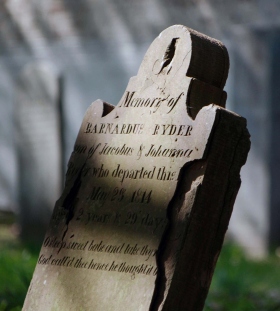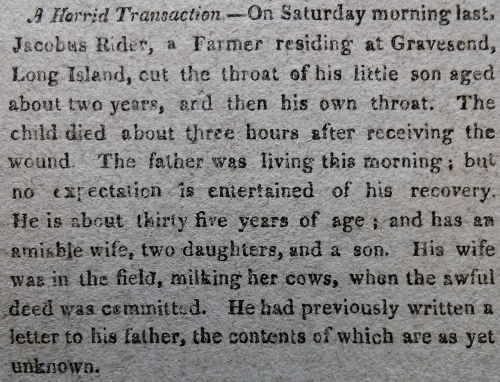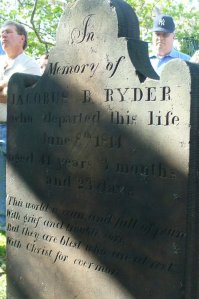
Barnardus Ryder stone (d. 1814), Gravesend Cemetery. (Photograph by Ned Berke, 2010. Used by permission.)
Near the center of Brooklyn’s Gravesend Cemetery stand two unexceptional sandstone markers from the early nineteenth century, separated only by the crumbled remains of a third stone between them. Like many stones in this fragile graveyard, they are cracked and flaking. Parts of their inscriptions are chipped and missing. The southern stone tilts back precariously. It reads:
[In]
Memory of
BARNARDUS RYDER
son of Jacobus & Johanna
Ry[de]r who departed this
[life] May 29, 1814
age[d] 2 years & 29 day[s.]
O sleep sweet babe and take thy r[est]
God call’d thee hence he thought it b[est]
The other says:
In
Memory of
JACOBUS B. RYDER
who departed this life
June 8th 1814
aged 44 years 3 months
and 23 days.
This world is vain and full of pain
With grief and trouble sore
But those are blest who are at rest
With Christ for evermore.
Those of us who frequent cemeteries know that stones with a common surname, standing near each other, usually mark the graves of family members. If the stones bear close or identical dates of death, the implication is that contagion carried off multiple relatives, as it did for eons before the advent of standardized sanitation and medical care.

Account of the Van Sicklen family tragedy, Brooklyn Daily Eagle, Saturday, August 25, 1849, p. 3, col. 1. [Click image to enlarge.]
One might assume that because they died ten days apart, Barnardus and Jacobus (pronounced ya-CO-bus) Ryder succumbed to the same disease. The Gravesend Cemetery is peppered with other chronologically adjacent burials, like the five members of the Van Sicklen family who died of cholera between August 18 and 23, 1849 (see the article at left). Or Mathias Derby and his mother, Emelie, who died of scarlet fever two days apart in November 1895. And Richard Samuel Vanderbilt, who expired a week after catching a heavy cold at his son Richard’s funeral on January 30, 1919. Ida Voorhies, widow of Jacobus, died during her husband’s funeral on October 6, 1831, though whether from the “prevailing fever” that killed her husband, or from grief, is lost to time.
But assumptions often prove dangerously wrong. On Monday, May 30, 1814, the day after little Barnardus Ryder died, readers of the Commercial Advertiser, one of New York City’s leading newspapers, stumbled across this shocking report from the otherwise tranquil reaches of southern Kings County:

New York, Commercial Advertiser, Monday, May 30, 1814, p.2, col. 3. [Note: “Saturday morning last” = May 28, 1814.]
Newspapers up and down the eastern seaboard, from New Hampshire to Maryland, and as far inland as Ohio, recounted the tale of Gravesend’s “horrid transaction.” The version printed on June 1 in the Long-Island Star, Brooklyn’s leading weekly, managed to spell “Ryder” correctly, and added the detail that Jacobus — “long esteemed as a worthy and pious man, and . . . apparently in his right mind on the evening previous to the melancholy and dreadful act” — confessed in the letter to his father that he “imagined he heard a voice commanding him to execute the deed.” He lingered, sadly, until June 8, and died at the age of 44 years, three months, and 23 days. (As well as misspelling “Rider,” the newspapers all misstate his age: Jacobus was not “about thirty-five,” but, rather, nearly four months past 44.) The Long-Island Star ran a brief death notice on June 15:

Brooklyn, Long-Island Star, Wednesday, June 15, 1814, p. 3, col. 2. [Note: “Wednesday last” = June 8, 1814. The “28th ult.” = the 28th day of the previous month, i.e., May 28, 1814.]
His widow, Johanna, never remarried. She lived another 33 years, and died at age 65 on August 7, 1847. She is buried near Jacobus and Barnardus, and another infant son, William, who was born in 1804 and died in 1805, long before their family’s tragedy. The other children — Femmetie (1802-?), Johanna (1807-1894), and a second William (1809-?) — presumably all outlived their mother. They almost certainly did not hand down the terrible memories of 1814 to their descendants. May they rest in peace.

Jacobus B. Ryder stone (d. 1814), Gravesend Cemetery. (Photograph by Andrea Coyle, 2010. Used by permission.)
Copyright © 2014 by Joseph Ditta (webmaster@gravesendgazette.com)

